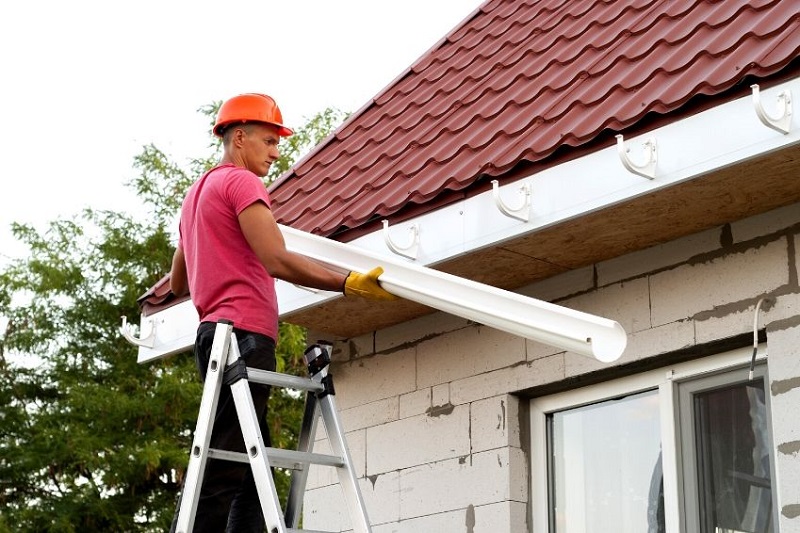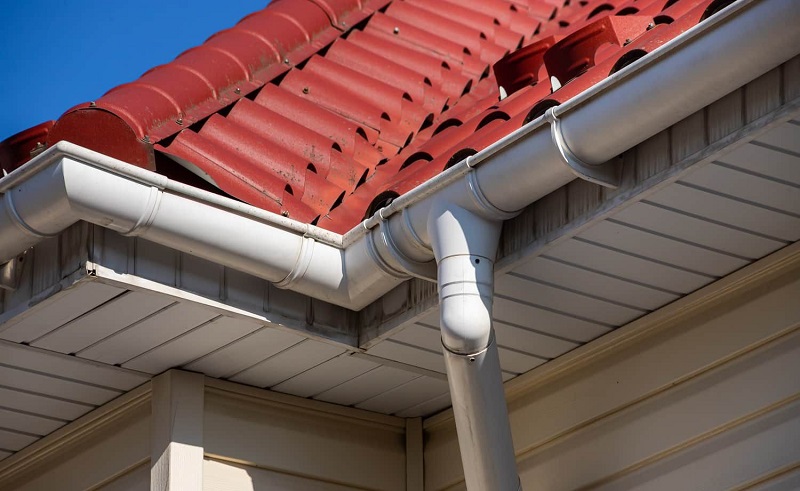Picture this: a heavy downpour, rainwater cascading off your roof like a waterfall. Now, imagine the chaos it could cause—soaked landscapes, weakened foundations, and potential damage to your home. This is where gutters come into play. In this guide, we’re going to explore the world of gutter installation and tackle the question that’s been on your mind: Can I put gutters on myself?
Setting the Scene: The Importance of Gutters
Before we dive into the nitty-gritty of DIY gutter installation, let’s understand why gutters are crucial. Gutters are like the unsung heroes of your home’s defense system. They divert rainwater away from your foundation, preventing erosion and structural damage. Without gutters, water can wreak havoc on your landscaping and even find its way into your home. Now that we’ve established their importance, let’s see if you’re up for the DIY challenge.
DIY Enthusiasm: Tackling Gutter Installation
There’s something immensely satisfying about taking matters into your own hands, especially when it comes to home improvement. Installing gutters can be a rewarding endeavor, but it’s important to know what you’re getting into. Let’s start by understanding the basics of gutters.
Understanding Gutters: A Brief Overview
What Are Gutters and Why Do You Need Them?
Gutters are channels that collect rainwater as it runs off your roof and direct it away from your home’s foundation. By doing so, they protect your home from water damage and structural issues. But before you jump into installation, let’s explore the different types of gutters available.
Types of Gutters: Exploring Your Options
Sectional Gutters
Sectional gutters are made up of individual pieces that are joined together during installation. They’re relatively easy to install and are suitable for smaller DIY projects.
Seamless Gutters
Seamless gutters are custom-made to fit your home’s dimensions, offering a sleek and continuous appearance. They require special equipment and skills for installation.
Vinyl Gutters
Vinyl gutters are lightweight, cost-effective, and resistant to rust. They’re a popular choice for DIYers due to their ease of installation.
Aluminum Gutters
Aluminum gutters are durable, lightweight, and available in a variety of colors. They’re corrosion-resistant and can be a great DIY option.
Benefits of Installing Gutters
Shielding Your Home: Preventing Water Damage
Gutters protect your home’s exterior by channeling water away from its foundation. This prevents soil erosion, foundation cracks, and potential flooding.
Landscaping Lifesaver: Protecting Your Garden
Properly installed gutters ensure that rainwater doesn’t wash away your precious landscaping efforts, keeping your garden intact.
Foundation Protection: Keeping Your Home Stable
By preventing excess moisture near your home’s foundation, gutters help maintain its stability and structural integrity.
Can You Tackle Gutter Installation Yourself?
DIY Mindset: Assessing Your Skills
Before you embark on this DIY journey, consider your skills and comfort level with basic tools and home improvement projects.
Time and Effort: Understanding the Commitment
Gutter installation requires time and dedication. It’s important to allocate sufficient time to complete the project without rushing.
Tools of the Trade: What You’ll Need
Ladder Safety
Ensure you have a stable ladder and follow safety guidelines to avoid accidents while working at heights.
Measuring and Cutting Tools
Accurate measurements and precise cuts are essential for a successful gutter installation. Invest in measuring tape and cutting tools.
Fasteners and Sealants
You’ll need appropriate fasteners to secure your gutters and sealants to prevent leaks at joints and corners.
Planning Your Gutter Installation Project
Sizing Up: Measuring Your Roof’s Dimensions
Measure your roof’s dimensions accurately to determine the amount of gutter material you’ll need.
Calculating the Ideal Slope for Water Flow
Gutters should have a slight slope to ensure proper water flow toward downspouts. Calculate this slope based on your roof’s size.
Mapping Out Downspout Locations: Strategic Placement
Plan where your downspouts will be located. They should be strategically placed to efficiently direct water away from your home’s foundation.
Safety First: Preparing for DIY Gutter Installation
Ladder Safety: Avoiding Common Risks
Place your ladder on a stable surface, avoid overreaching, and have a spotter when needed to ensure your safety.
Protective Gear: Gearing Up for Success
Wear appropriate protective gear, including gloves and safety goggles, to shield yourself from debris and potential hazards.
Checking Weather Conditions: Timing Matters
Choose a day with clear weather to avoid rain and wind that can make installation challenging.
Step-by-Step Guide: Installing Your Gutters
Gathering Your Materials: Double-Checking Your Checklist
Ensure you have all the necessary materials, tools, and fasteners before you begin installation.
Installing Fascia Brackets: Anchoring the Gutter System
Attach fascia brackets to support the weight of the gutters. These brackets are crucial for a secure installation.
Snapping Gutter Sections Together: Seamless vs. Sectional
Connect the gutter sections according to the type you’ve chosen. Follow manufacturer guidelines for seamless or sectional installation.
Ensuring Proper Slope: Letting Gravity Do Its Job
As you hang the gutters, make sure they have a slight slope to allow water to flow toward the downspouts.
Attaching End Caps and Corner Pieces: Seamless Look
Install end caps and corner pieces to give your gutters a finished and seamless appearance.
Mounting Downspouts: Guiding Water to the Right Places
Attach downspouts at strategic locations to ensure water is directed away from your home’s foundation and landscaping.
Pro Tips for a Successful Installation
Seamless Seamlessness: Achieving a Professional Look
To achieve a seamless look, make precise measurements and use proper techniques when connecting gutter sections.
Sealing the Deal: Proper Use of Sealants
Apply sealants at joints and corners to prevent leaks and ensure a watertight installation.
Testing, Testing: Ensuring Water Flows Freely
After installation, run water through the gutters to confirm they’re properly sloped and water flows smoothly.
Common Mistakes to Avoid
Incorrect Slope: Preventing Water Pooling
Ensure you’ve calculated and implemented the correct slope to prevent water from pooling in the gutters.
Loose Fasteners: Securing Gutters for the Long Haul
Double-check that all fasteners are tightly secured to prevent gutters from coming loose over time.
Poor Downspout Placement: Directing Water Away from Foundations
Strategically position downspouts to guide water away from your home’s foundation and landscaping.
When to Call in the Pros
Recognizing Complex Roof Structures
If your roof has intricate features, such as multiple angles or levels, it might be best to seek professional help.
Dealing with Height and Safety Concerns
For roofs with steep slopes or great heights, professionals have the experience and equipment to safely handle the installation.
Time Constraints: Hiring Help for Efficiency
If you’re pressed for time or lack the necessary tools, hiring professionals can ensure a swift and accurate installation.
Maintaining Your DIY Gutters
Seasonal Cleaning: Keeping Debris at Bay
Regularly clean your gutters to prevent clogs and ensure proper water flow.
Inspecting for Damage: Catching Issues Early
Check for leaks, loose fasteners, and any signs of damage to address problems before they escalate.
Repairing Minor Leaks: DIY Fixes
If you notice minor leaks, address them promptly using appropriate sealants and patches.
Long-Term Benefits of Your DIY Gutter Installation
Home Value Boost: Adding an Attractive Feature
Well-installed gutters enhance your home’s curb appeal and can increase its overall value.
Savings on Repairs: Preventing Water-Related Damage
By preventing water damage, you’ll save money on potential repairs to your foundation and landscaping.
Personal Accomplishment: Enjoying Your Handiwork
The satisfaction of a DIY project done well adds a personal touch to your home and boosts your confidence in tackling other tasks.
Conclusion
In the world of home improvement, installing gutters can be a rewarding and empowering endeavor. By taking the DIY route, you not only protect your home and enhance its aesthetics but also gain a sense of accomplishment. So, can you put gutters on yourself? Absolutely! Armed with the right knowledge, tools, and a bit of patience, you can successfully install gutters and safeguard your home. This wise investment will pay off in the long run, giving you peace of mind and a home that’s ready to weather any storm.
FAQs
Q1: Is gutter installation a difficult DIY project?
Installing gutters requires careful planning, precise measurements, and the use of appropriate tools. While it’s not overly complicated, it does require attention to detail.
Q2: Can I install seamless gutters on my own?
Seamless gutter installation can be more challenging due to the need for specialized equipment. It’s recommended to have some DIY experience before attempting seamless gutter installation.
Q3: How often should I clean my gutters?
Regular gutter cleaning is recommended at least twice a year, ideally in the spring and fall, to prevent clogs and ensure proper water flow.
Q4: Can I use any type of sealant for gutter installation?
It’s important to use sealants that are specifically designed for gutter installation. Silicone-based sealants are commonly used for this purpose.
Q5: Are gutters purely functional, or do they have aesthetic value too?
While gutters primarily serve a functional purpose, they can also enhance your home’s curb appeal and contribute to its overall aesthetics.





